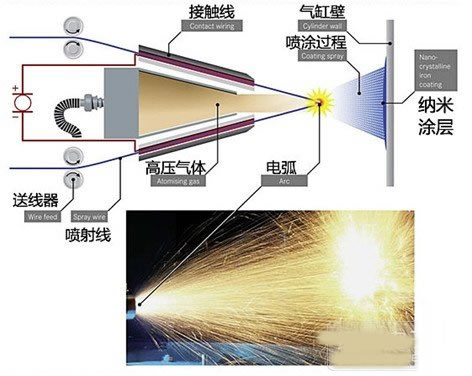Five years ago, Mercedes-Benz began to exclusively use "double wire arc spraying technology" on its high-performance AMG engine; now Mercedes-Benz has begun to apply this technology on practical mass production models, the first to enjoy this The technical benefit is the Mercedes-Benz diesel engine. And this technology has a more fashionable name - NANOSLIDE nano-scale cylinder wall coating technology.
This article refers to the address: http://
This technology instantly melts the coating material such as iron or carbon by high-voltage arc, and then uniformly sprays it onto the inner wall of the lightweight aluminum alloy cylinder under the push of high-pressure airflow. In this way, a mirror-like smooth and bright nano-crystal coating is formed on the inner wall surface of the cylinder. The surface of the coating is smooth and densely covered with small holes. Such a structure is perfect for reducing the friction between the piston and the cylinder wall. . Similarly, the ultra-thin coating replaces the heavy steel cylinder liner, which greatly reduces the overall quality of the engine. Reducing friction means lower fuel consumption and lower exhaust emissions. AMG's 6.3L V8 engine has benefited from this technology since 2006.

It is well known that Mercedes-Benz's BlueEFFICIENCY blue performance technology is a combination of different energy-saving technologies. It has already included technologies that can significantly reduce fuel consumption and emissions, such as aerodynamic optimization, material weight reduction, and ground rolling tires. Now the blue performance family is welcoming a new partner, NANOSLIDE technology.
Compared with the currently widely used 5mm gray iron cylinder liner, the practical significance of NANOSLIDE technology is to raise the production standard of engine cylinder liner to the new standard of art. The iron or carbon coating that is melted and sprayed onto the surface of the cylinder wall is deposited as an ultra-fine nanocrystalline coating. This is called the NANOSLIDE coating and then subjected to a special honing process. The final thickness of the coating is only 0.1 mm to 0.15. Mm, with a mirror-like smooth surface finish. The fine pores generated during the honing process can effectively retain the lubricating oil, thus ensuring optimal lubrication of the piston. This result is not only that the mechanical friction loss of the cylinder of the NANOSLIDE coating is reduced by 50% compared to the conventional gray cast iron cylinder liner, but also has a very high wear resistance.
In view of the experience of these technologies, the Mercedes-Benz world's first diesel engine with NANOSLIDE cylinder wall coating technology has lost 4.3 kg and an additional 3% reduction in fuel consumption. Taking the V6 diesel engine applied to the ML350 BLUETEC as an example, the new 2987cc displacement diesel engine has an output of 258 hp and a peak torque of 620 Nm. The emission has reached the Euro 6 standard, and the overall fuel consumption is only 6.8 L/100 km. The carbon dioxide emissions per kilometer also dropped from 235g to 179g, and NANOSLIDE technology can be said to have contributed.
This technology makes the author think that at the 2011 Global Automotive Media Summit held in Chengdu recently, Paul Ingrassia, deputy editor of Thomson Reuters News, repeatedly reiterated that the internal combustion engine is far from being eliminated, through a series of new technology applications, internal combustion engines. Always evolving in the era of following. I believe that it will not take long for NANOSLIDE technology to lead a new round of automotive engine technology leap.
Copper not only has excellent thermal conductivity, but also has good antirust ability. The size of the radiator is generally determined by the size of the fan. Common radiator specifications have a radiator match with one pieces of 120mm fan, people are used to call this radiator 120. The radiator that can match two pieces of 120mm fans is 240. And so on, there are 360 and 480 radiator.
Pure Copper Radiator,Copper Cooling Heatsink,Liquid Cooling Radiators,Computer Water Radiator
Dongyuan Syscooling Technology Co., Ltd. , https://www.syscooling.com
